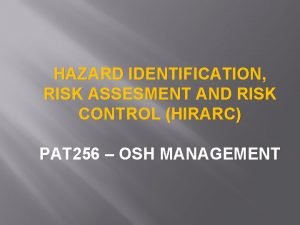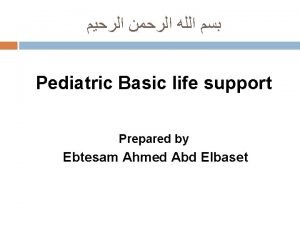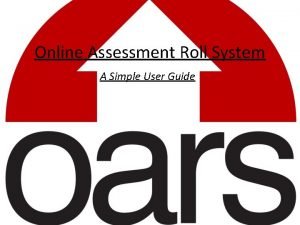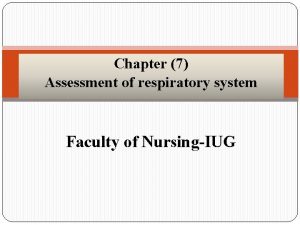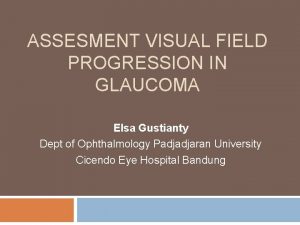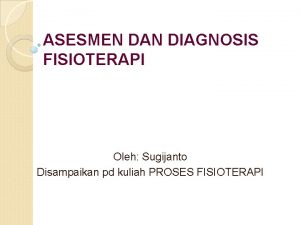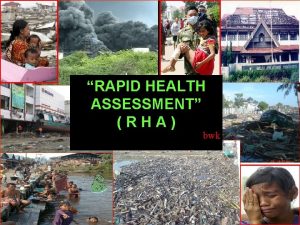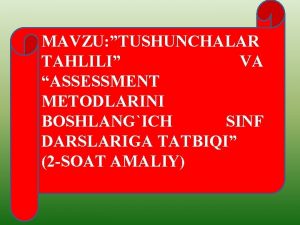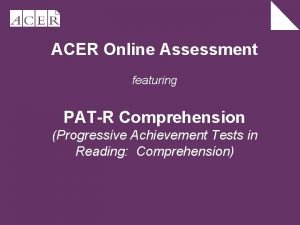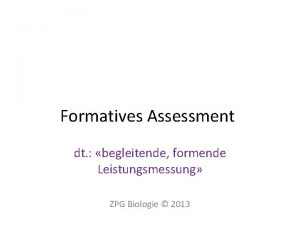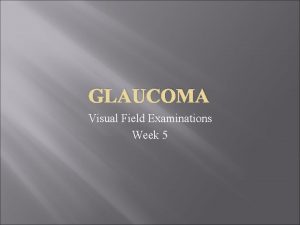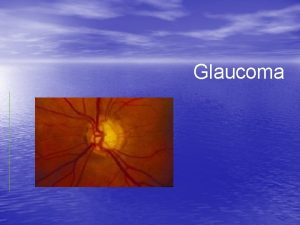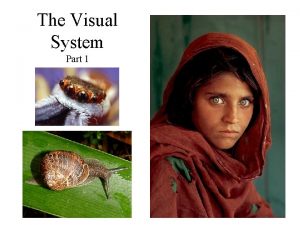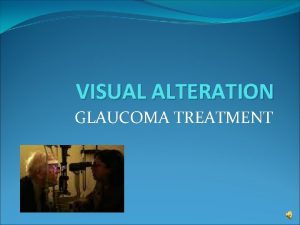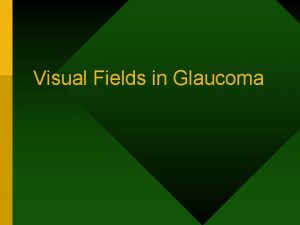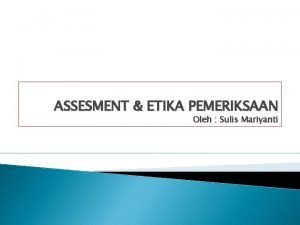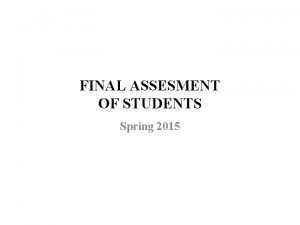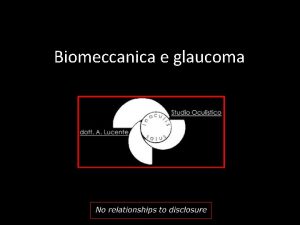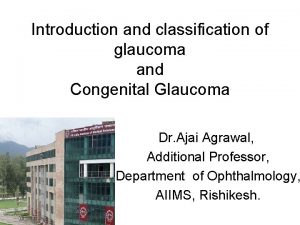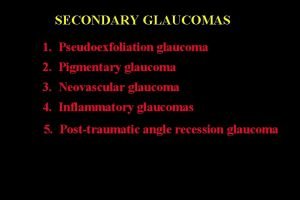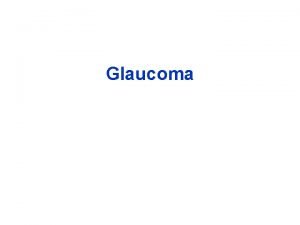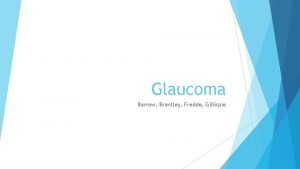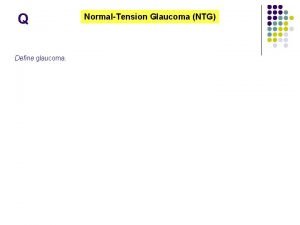ASSESMENT VISUAL FIELD PROGRESSION IN GLAUCOMA Elsa Gustianty




















- Slides: 20

ASSESMENT VISUAL FIELD PROGRESSION IN GLAUCOMA Elsa Gustianty Dept of Ophthalmology Padjadjaran University Cicendo Eye Hospital Bandung

Changing Paradigms of Progression Progressive optic neuropathy • All patient is progress at different rates Treatment goal • To halt or slow progression • Rate of progression and life expectancy. One of must the be Clinician able to most challenging • Identify high risk patient task and measure • Detect progression

Structure vs Function Testing Which one is better to detect progression? Should we choose one method vs the other ? 25% to 50% of RGCs lost before SAP abnormality Vice versa Combined both testing Choose base on the stage of glaucoma Early stage use OCT, moderate to advance stage use HVF to detect progression.

Visual Function Progression Assesment Establishing a baseline Follow-up data collection Progression Analysis Manifestation of Progression 1. 2. 3. 4. Conversion from normal to abnormal. New defect in a normal region of an abnormal baseline fields. Worsening of a defect Staging of disease, move from one category to another. The Humphrey Guided Progression Analysis (GPA)

Baseline Data Collection - first 2 years A good baseline of reliable VFs is essensial. White-on-white SAP, at least 24 -2. At least 2 reliable VFs in the first 6 months. At least 2 further VFs within the next 18 months. Ideal : 6 VFs in 2 years to rule out rapid progression (-2 d. B/year or worse) Remove from the analysis : obvious learning effect, high FP, obvious artifact. Established a new baseline after significant therapeutic intervention as surgery. Weinreib RN et all. Progression of Glaucoma. WGC. Consensus series-8. Kugler Pub. 2011.

Follow-up data collection – after 2 years § § Conducted by the same strategy. Low-moderate risk : 1 VF/year. High risk : 2 VFs/year. Repeated sooner if : progression is identified on the basis of an event analysis Clinically noted or measured by imaging suggestive of progression include a splinter hemorrhage, inadequate IOP control.

3. Progression Analysis Approach Event-based Analysis Determines VF progression on a predefined change in VF parameter test-retest variability Used early when few VFs available for analysis Trend-based Analysis Determine rate of change and to assess the risk of future visual disability Used later in the follow up Using linear regression of VFI and MD overtime Calculated automatically when >5 VFs available

Physiologic Fluctuation 1. 2. Transient and reversible. Occurs in normal and abnormal fields. Greater in in abnormal location in abnormal fields. Short-term fluctuation (test-retest error) is a measurement error. Long-term fluctuation (test-retest variability) is an funnctional actual variation from one time to another

Humphrey Guided Progression Analysis (GPA) q q q The recently introduced and the most widely available. Provides an event-based and a trend-based analysis. GPA Summary Report which show baseline fields, trend analysis of all test, event analysis of the most recent test. Heijl A. Patella VM. Bengtsson. The Field Analyzer Primer. Effective Perimetry. 4 th ed. 2012.

GPA report Single field analysis with GPA Full GPA report GPA- baseline GPA- follow-up GPA Summary Report Heijl A. Patella VM. Bengtsson. The Field Analyzer Primer. Effective Perimetry. 4 th ed. 2012.

GPA-Event Analysis Glaucoma Change Probability Map (GCPM) highlight Pattern Deviation values that have deteriorated from baseline by more than the 95 th percentile of random variability seen in patients having similar level of defect.

Symbols used in GCPM

GPA Alert Possible Progression q When > 3 test points show statistically significant deterioration on two consecutive follow up compare to baseline of two fields test. Likely Progression q When the same > 3 test points significantly deteriorated test points appear in at least three consecutive follow-up tests.

Attention q q q Needs 5 FVs : 2 baseline and at least 3 followup GCPMs are not calculated for fields having an MD value worse than -20 d. B. When evaluating GCPMs the user should expect that each test point will have a 5% risk of being falsely flagged, simply from random test variability. Fields that truly are worsening will show reproducible change. Credible change must be seen at multiple test point location.

GPA-Trend Analysis : VFI New global index: Visual Field Index (VFI) VFI is a single number that summerizes each patient VF status as a percentage of the normal age-corrected sensitifity. Normal : VFI 100% Blind : VFI 0%

VFI was designed to approximatelly reflect retinal ganglion cell loss. VFI gives central test point more weight than peripheral ones. VFI 92%------8% MD -0. 77%--2. 5%

GPA- Trend Analysis: VFI graph • Linier regressio of VFI overtime • VFI plotted versus patient age. • Automatically displayed whenever sufficient number of VFs is available

GPA performs a linear regression analysis into the future. When > 5 examination Covering > 2 years 95% CI of VFI slope < + 2, 5% are available,

Interpreting VFI Progression Rates To indicate what could happen if the trends continue Consider patient’s curent visual function and life expectancy. Minimal goal is to retain at least a VFI of 50% in the better eye.

Thank you…
 Idoe tide
Idoe tide Hirac format
Hirac format Ebtesam ahmed
Ebtesam ahmed Assessment roll
Assessment roll Chapter 7 assesment
Chapter 7 assesment Wireless assesment
Wireless assesment Essensial assesment
Essensial assesment Sample brief lesson plan
Sample brief lesson plan Assessment strategy
Assessment strategy Diagnosis fisioterapi adalah
Diagnosis fisioterapi adalah Ecological risk assesment
Ecological risk assesment Kapan dilakukan rha
Kapan dilakukan rha Assessment metodi
Assessment metodi Caf courses
Caf courses Acer online assessment
Acer online assessment Informative assessment activities
Informative assessment activities It assessment
It assessment Zpg biologie 2018
Zpg biologie 2018 Nursing care plan of cataract
Nursing care plan of cataract Acute glucoma
Acute glucoma Triggerfish glaucoma
Triggerfish glaucoma

